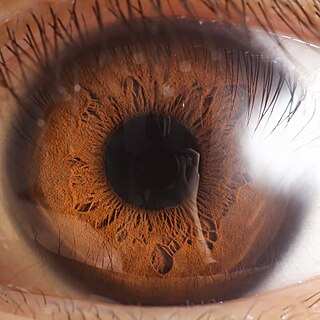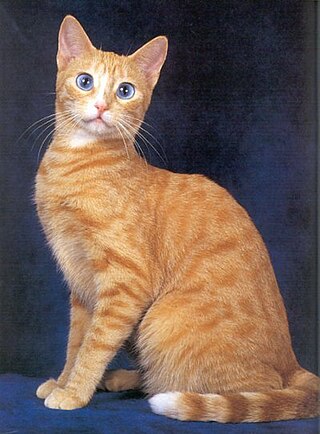Pike, Pikes or The Pike may refer to:

The walleye, also called the walleyed pike, yellow pike, yellow pikeperch or yellow pickerel, is a freshwater perciform fish native to most of Canada and to the Northern United States. It is a North American close relative of the European zander, also known as the pikeperch. The walleye is sometimes called the yellow walleye to distinguish it from the blue walleye, which is a color morph that was once found in the southern Ontario and Quebec regions, but is now presumed extinct. However, recent genetic analysis of a preserved (frozen) 'blue walleye' sample suggests that the blue and yellow walleye were simply phenotypes within the same species and do not merit separate taxonomic classification.

The iris is a thin, annular structure in the eye in most mammals and birds that is responsible for controlling the diameter and size of the pupil, and thus the amount of light reaching the retina. In optical terms, the pupil is the eye's aperture, while the iris is the diaphragm. Eye color is defined by the iris.

The tapetum lucidum is a layer of tissue in the eye of many vertebrates and some other animals. Lying immediately behind the retina, it is a retroreflector. It reflects visible light back through the retina, increasing the light available to the photoreceptors.

The sclera, also known as the white of the eye or, in older literature, as the tunica albuginea oculi, is the opaque, fibrous, protective outer layer of the eye containing mainly collagen and some crucial elastic fiber.

The Maumee River is a river running in the United States Midwest from northeastern Indiana into northwestern Ohio and Lake Erie. It is formed at the confluence of the St. Joseph and St. Marys rivers, where Fort Wayne, Indiana has developed, and meanders northeastwardly for 137 miles (220 km) through an agricultural region of glacial moraines before flowing into the Maumee Bay of Lake Erie. The city of Toledo is located at the mouth of the Maumee. The Maumee was designated an Ohio State Scenic River on July 18, 1974. The Maumee watershed is Ohio's breadbasket; it is two-thirds farmland, mostly corn and soybeans. It is the largest watershed of any of the rivers feeding the Great Lakes, and supplies five percent of Lake Erie's water.
Blue eyes is a common pigmentation in the iris of an eye of a mammal.

Ojos Azules was a breed of shorthaired domestic cat with unusual blue or odd eyes caused by a dominant blue eye (DBE) genetic mutation. The breed came in all coat colors; however, only particolors, colorpoints, and intermediate colors with a characteristic white tail tip were permitted. The breed also had a semi-longhaired coat variety, the Ojos Azules Longhair. Due to the lethal side effects of the Ojos Azules gene, breeders stopped working with this blue eye mutation.

The blue walleye, also called the blue pike, was a unique color morph of walleye which was endemic to the Great Lakes of North America. Morphometric studies led biologists to classify the blue walleye as a separate species in 1926, although it was later downgraded to a subspecies. Listed as an endangered species by the United States in 1967, it was declared extinct in 1983.

The telescope, telescope goldfish or telescope eye is a goldfish characterised by its protruding eyes. It was first developed in the early 1700s in China, where the trait was referred to as dragon eyes.

Wabamun Lake is one of the most heavily used lakes in Alberta, Canada. It lies 65 kilometres (40 mi) west of Edmonton. It is 19.2 kilometres (11.9 mi) long and 6.6 kilometres (4.1 mi) wide, covers 82 square kilometres (32 sq mi) and is 11 metres (36 ft) at its deepest, with somewhat clear water.

Horses exhibit a diverse array of coat colors and distinctive markings. A specialized vocabulary has evolved to describe them.

Markings on horses are usually distinctive white areas on an otherwise dark base coat color. Most horses have some markings, and they help to identify the horse as a unique individual. Markings are present at birth and do not change over the course of the horse's life. Most markings have pink skin underneath most of the white hairs, though a few faint markings may occasionally have white hair with no underlying pink skin. Markings may appear to change slightly when a horse grows or sheds its winter coat, however this difference is simply a factor of hair coat length; the underlying pattern does not change.

The Toledo Zoo & Aquarium, located in Toledo, Ohio is a member of the World Association of Zoos and Aquariums (WAZA), and is accredited by the Association of Zoos and Aquariums (AZA). The Toledo Zoo & Aquarium houses over 10,000 individual animals from 720 species and participates in around 80 species survival programs.

An odd-eyed cat has one blue eye and one eye either green, yellow, amber, or brown. This is a feline form of complete heterochromia, a condition that occurs in some other animals, including humans. There is also sectoral (partial) heterochromia, where two different colours occur within the same iris. The condition most commonly affects solid white cats, but may be found in cats of any coat colour.
The wildlife of Alaska is both diverse and abundant. The Alaskan Peninsula provides an important habitat for fish, mammals, reptiles, and birds. At the top of the food chain are the bears. Alaska contains about 70% of the total North American brown bear population and the majority of the grizzly bears, as well as black bears and Kodiak bears. In winter, polar bears can be found in the Kuskokwim Delta, St. Matthew Island, and at the southernmost portion of St. Lawrence Island. Other major mammals include moose and caribou, bison, wolves and wolverines, foxes, otters and beavers. Fish species are extensive, including: salmon, graylings, char, rainbow and lake trout, northern pike, halibut, pollock, and burbot. The bird population consists of hundreds of species, including: bald eagles, owls, falcons, ravens, ducks, geese, swans, and the passerines. Sea lions, seals, sea otters, and migratory whales are often found close to shore and in offshore waters. The Alaskan waters are home to two species of turtles, the leatherback sea turtle and the green sea turtle. Alaska has two species of frogs, the Columbia spotted frog and wood frog, plus two introduced species, the Pacific tree frog and the red-legged frog. The only species of toad in Alaska is the western toad. There are over 3,000 recorded species of marine macroinvertebrates inhabiting the marine waters, the most common being the various species of shrimp, crab, lobster, and sponge.
The silver lamprey is a lamprey commonly found in the Northern and Central United States, as well as a large part of southern Canada. Its binomial name means "sucking fish" in Greek and "one-pointed" in Latin. The silver lamprey is a member of the class Agnatha, sometimes referred to as cyclostomes (round-mouths). Other common names include: bloodsucker, blue lamprey, hitch-hiker, lamper, lamprey eel, northern lamprety. The silver lamprey should not be confused with the sea lamprey, which has caused considerable damage to native fish populations in the Great Lakes region.

The Toledo Walleye are a professional ice hockey team based in Toledo, Ohio. The Walleye are members of the Central Division of the Western Conference of the ECHL. The Walleye were founded in 1991 as the Toledo Storm and play their home games at the Huntington Center, which opened in 2009. Since the beginning of the 2009–10 season, the team has been affiliated with the Detroit Red Wings of the National Hockey League and the Grand Rapids Griffins of the American Hockey League with an agreement in place through the 2023–24 season.

Congenital sensorineural deafness occurs commonly in domestic cats with a white coat. It is a congenital deafness caused by a degeneration of the inner ear. Deafness is far more common in white cats than in those with other coat colours.

Vision is an important sensory system for most species of fish. Fish eyes are similar to the eyes of terrestrial vertebrates like birds and mammals, but have a more spherical lens. Birds and mammals normally adjust focus by changing the shape of their lens, but fish normally adjust focus by moving the lens closer to or further from the retina. Fish retinas generally have both rod cells and cone cells, and most species have colour vision. Some fish can see ultraviolet and some are sensitive to polarised light.















